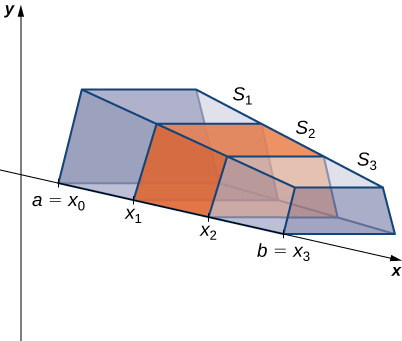| << Chapter < Page | Chapter >> Page > |
Because the cross-sectional area is not constant, we let represent the area of the cross-section at point Now let be a regular partition of and for let represent the slice of stretching from The following figure shows the sliced solid with

Finally, for let be an arbitrary point in Then the volume of slice can be estimated by Adding these approximations together, we see the volume of the entire solid can be approximated by
By now, we can recognize this as a Riemann sum, and our next step is to take the limit as Then we have
The technique we have just described is called the slicing method . To apply it, we use the following strategy.
Recall that in this section, we assume the slices are perpendicular to the Therefore, the area formula is in terms of x and the limits of integration lie on the However, the problem-solving strategy shown here is valid regardless of how we choose to slice the solid.
We know from geometry that the formula for the volume of a pyramid is If the pyramid has a square base, this becomes where denotes the length of one side of the base. We are going to use the slicing method to derive this formula.
We want to apply the slicing method to a pyramid with a square base. To set up the integral, consider the pyramid shown in [link] , oriented along the

We first want to determine the shape of a cross-section of the pyramid. We are know the base is a square, so the cross-sections are squares as well (step 1). Now we want to determine a formula for the area of one of these cross-sectional squares. Looking at [link] (b), and using a proportion, since these are similar triangles, we have
Therefore, the area of one of the cross-sectional squares is
Then we find the volume of the pyramid by integrating from (step
This is the formula we were looking for.
Use the slicing method to derive the formula for the volume of a circular cone.
If a region in a plane is revolved around a line in that plane, the resulting solid is called a solid of revolution , as shown in the following figure.


Notification Switch
Would you like to follow the 'Calculus volume 1' conversation and receive update notifications?